My love for the GR Yaris is something I proudly believe could rival that of most others, but I still can’t shake the nagging doubt I have about its appearance. “Could the GR Yaris actually look… uncool?” This question has been smoldering in my heart for a while.
As with all other pages on this site, the content of this page is entirely based on my personal opinion, shaped by my subjective view. Please bear this in mind as you continue reading.
Regarding my dissatisfaction with the rear view of the GR Yaris and my suggestions for improvement, I’ve already covered this on another page, so please refer to that. As for the front and front diagonal views, I have plenty of thoughts, but I’ve decided not to dwell on those here.
What I want to point out in this article is the strange flat surfaces, curves, and press lines visible when viewing the GR Yaris from the side. These odd design elements might give onlookers the subtle feeling of “Is this really cool?” That’s what I suspect.
For those who prioritize design over performance, this feeling of discomfort might even lead to regretting their purchase of the GR Yaris. (For more details, please refer to the article “If You Regret Buying the GR Yaris…“)
First, let me show you a photo where the press line is clearly visible. (Photo 1)
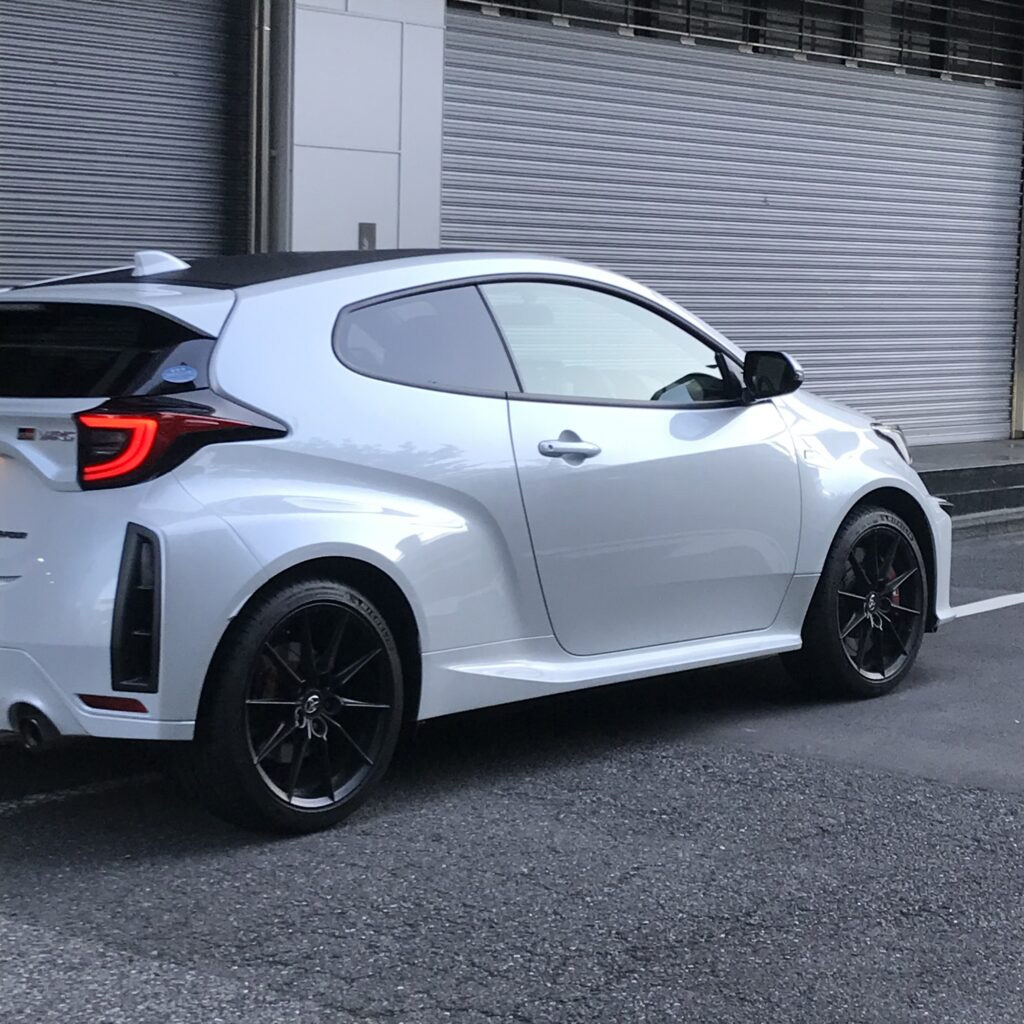
I’ve circled the press line I find questionable in bold. (Photo 2)
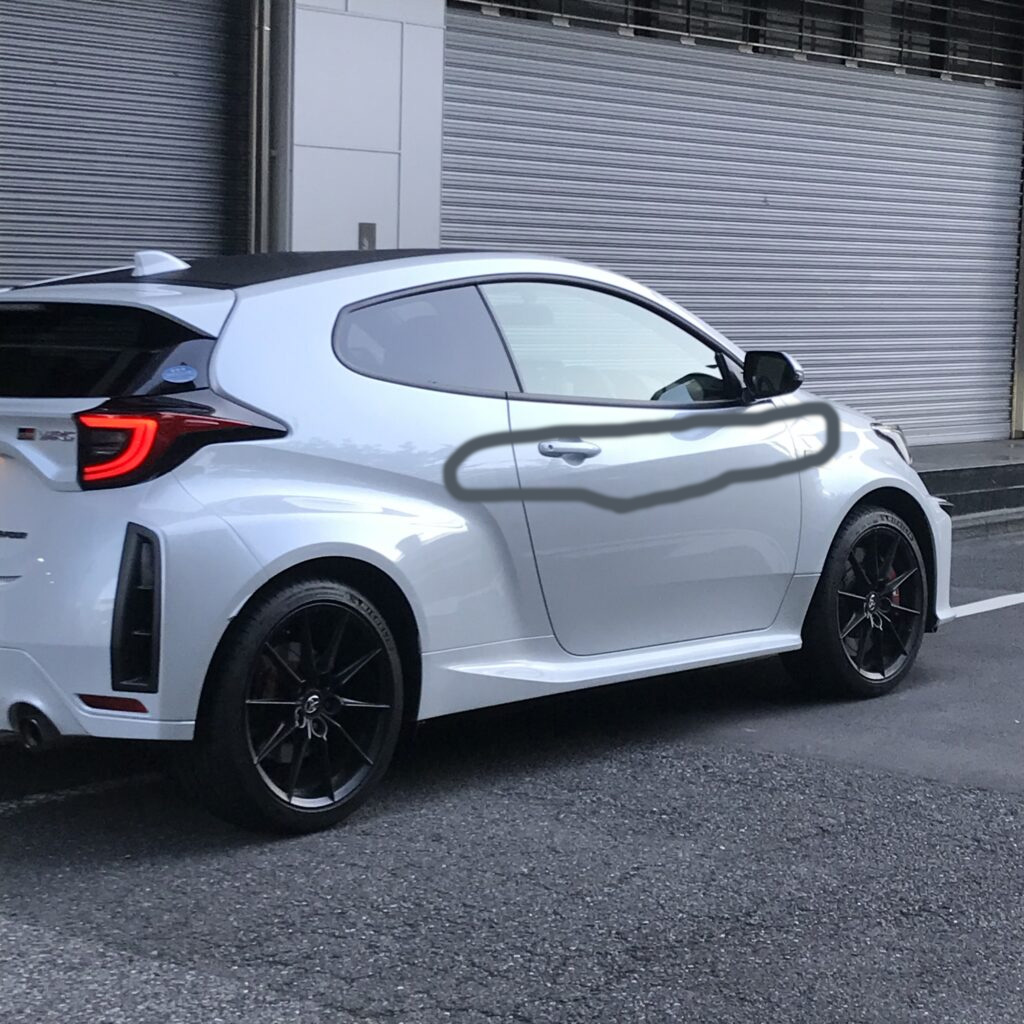
Why does the press line drop towards the rear? Wouldn’t it look better if it rose towards the rear? (I’ll compare this with the side line of the GR Supra later.)
At the very least, it should have been horizontal here! I can’t believe a sporty compact car like this has a press line that slants downwards towards the back. Honestly, it’s disappointing.
Most of the cool GR Yaris photos circulating in the media cleverly hide or obscure this press line. The photo below (Photo 3) is likely from Toyota’s publicity materials, and it makes the GR Yaris look great. However, the downward sloping press line on the side that I’ve pointed out is skillfully concealed with shadows.
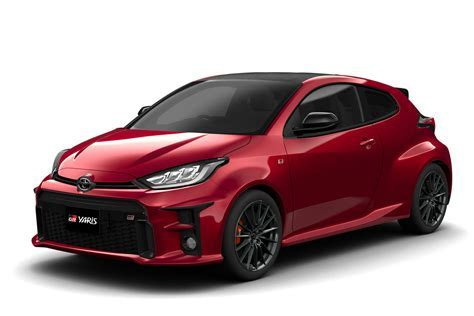
Next, if you look at the image I borrowed from the later model’s web catalog (Photo 4), you’ll see that this press line starts from the front garnish, runs over the top edge of the headlights, and forms a single curve. In other words, it’s a line that runs more than halfway around the car, slanting down towards the rear.
It’s as if they were designing an airplane, not a car…
A sports car designed to zip along the ground should give viewers the impression of slicing through the air like a razor, with a sharp, sleek forward profile. That would give the car a stronger appeal, in my opinion.
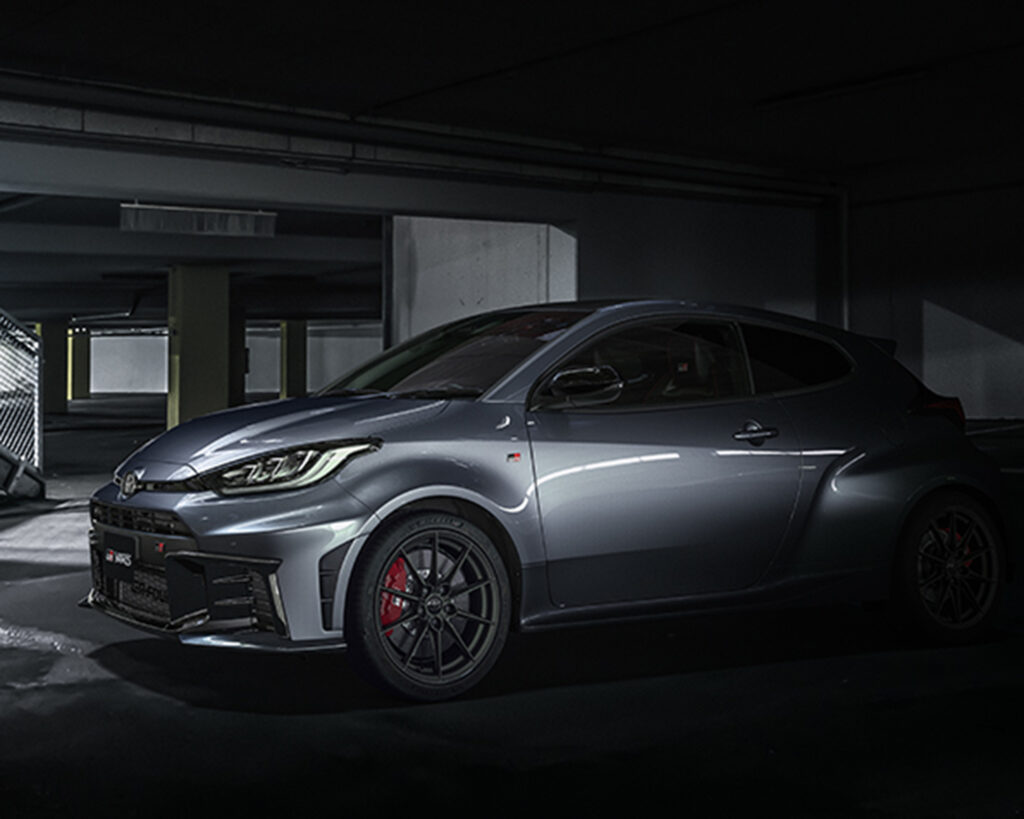
Maybe there was an ambitious designer who wanted to introduce a new direction in sports compact car design.
By the way, this downward sloping line can also be seen, albeit faintly, on the 4-door Yaris. This suggests to me that a fairly high-ranking designer had the intention of unifying the design concepts of the GR Yaris and the standard Yaris.
Let’s stop pretending to know everything for a moment and move on.
I also feel a strong sense of discomfort with the press line encircled in blue in the photo below (Photo 5).
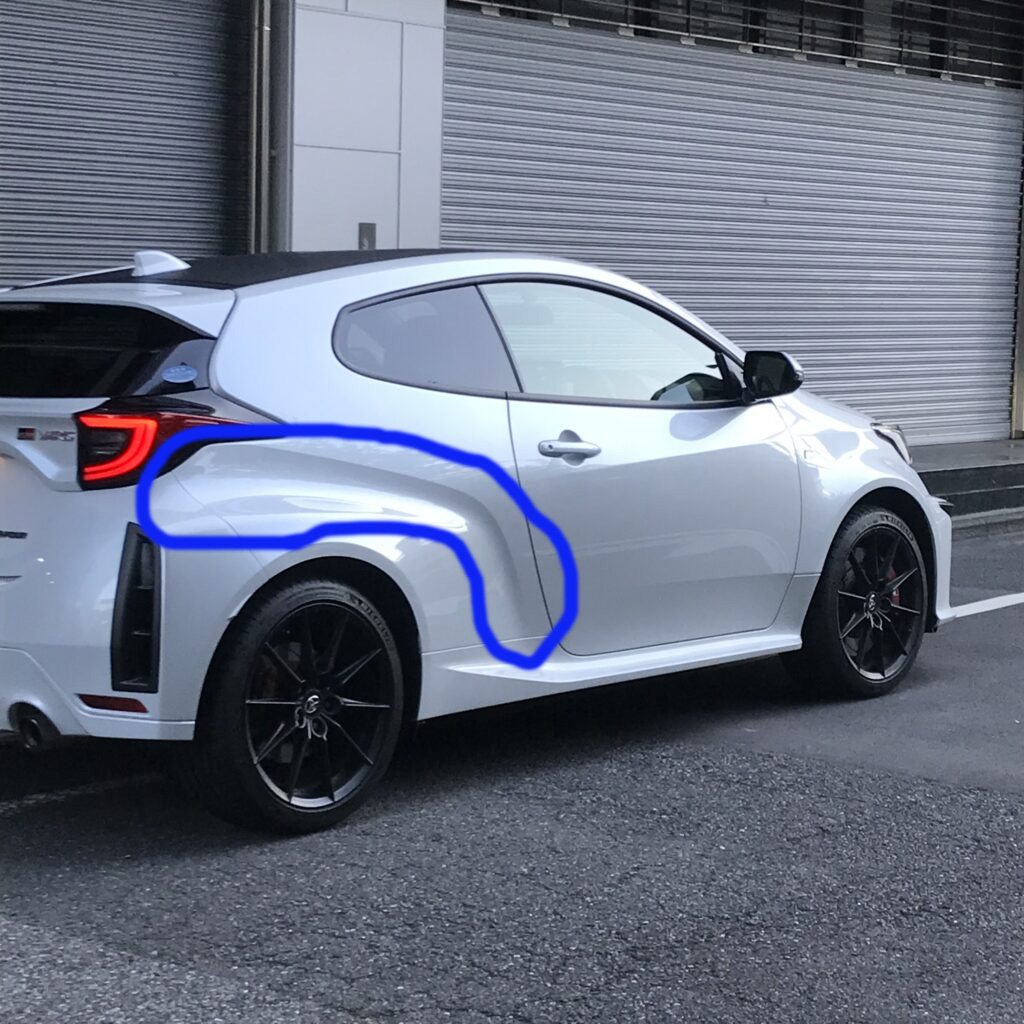
This press line seems to aim at visually emphasizing the rear over-fender, but it consists of double lines (and sometimes even triple lines depending on the angle), which ends up emphasizing the indent at the start of the fender’s bulge more than the bulge itself.
The impact of this design flaw is akin to the exaggerated eyeliner some gals wear that makes them look like they’re rolling their eyes back… Does that make sense?
If not, I apologize.
Moreover, it feels as if this downward sloping press line is clashing with the side press line (Photo 6), killing the sense of speed that a car’s profile should have. (See the asterisk in Photo 6.)
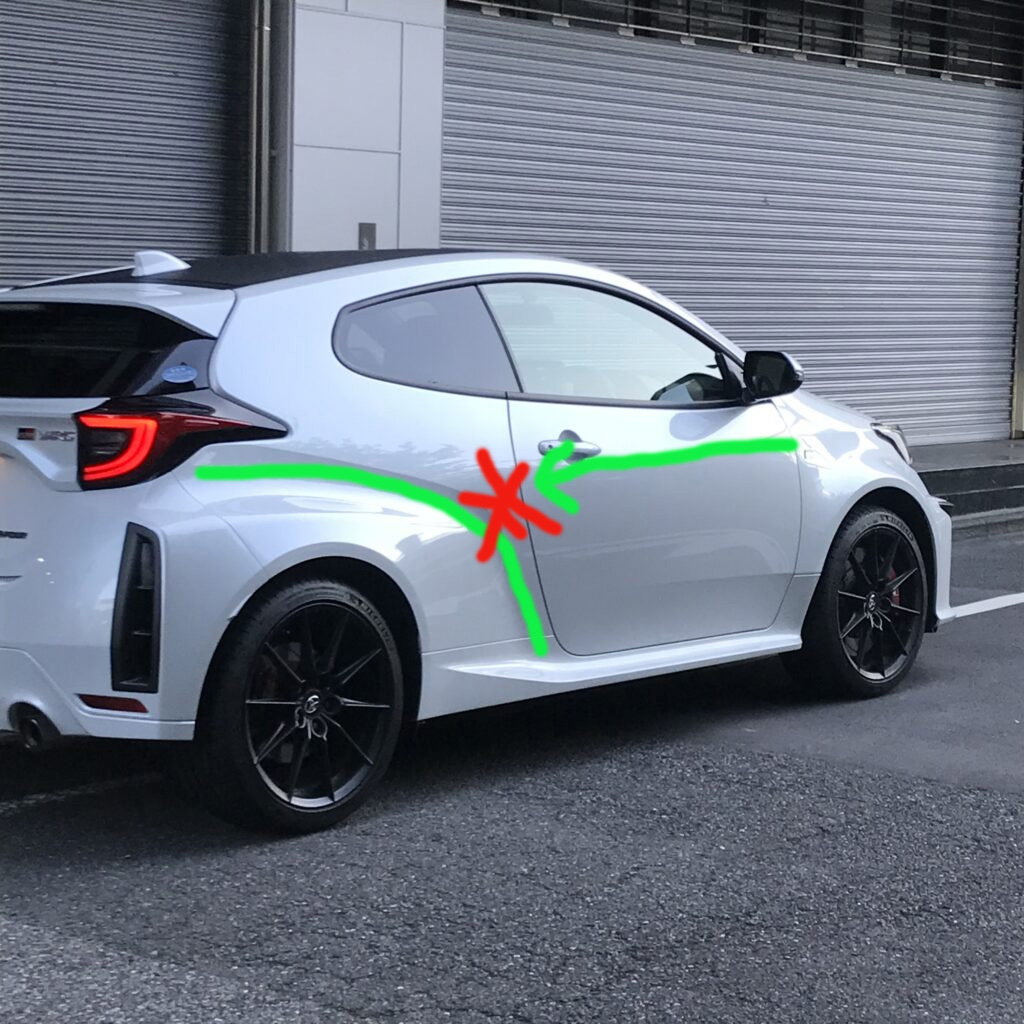
Let’s take a look again at the photo of the earlier model GR Yaris from Toyota’s publicity materials (Photo 7).

Here, the downward sloping side press line and the double press lines rising at the rear fender are cleverly hidden, giving the car a sense of speed, with the bulging fender highlighted.
Except for the roofline, the rear seems to rise towards the back.
This photo makes sure viewers aren’t aware of the spots where the two press lines I’ve pointed out clash and disrupt the sense of speed.
In this publicity photo, the sense of speed and the fender bulge are emphasized by a professional photographer and a master of post-production. But when you look at the actual car, these uncomfortable points I’ve mentioned become quite apparent.
And finally, the top-ranking discomfort for me is the flat surface design circled in red in the photo below (Photo 8).
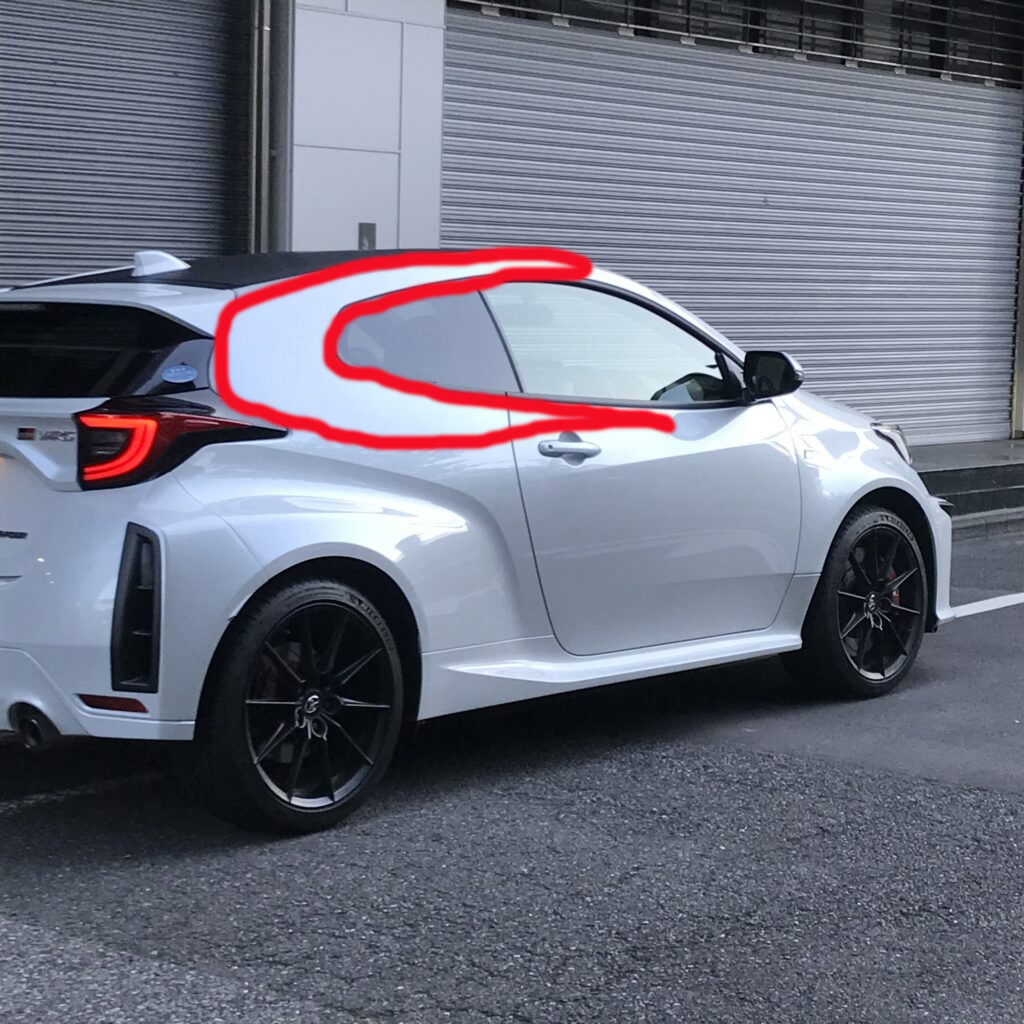
This part of the design is so flat and disconnected from the adjacent sections that it almost feels like the designer gave up here.
If I had to find another similarly flat section elsewhere on the car, it would be…
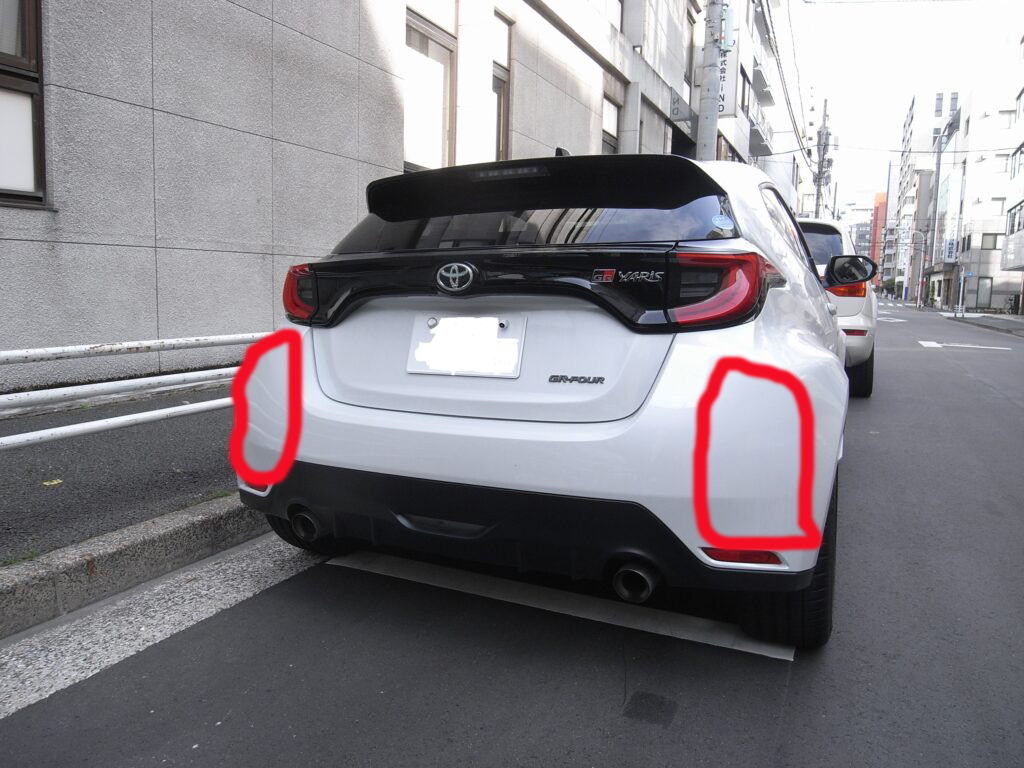
Here! (Photo 8)
The rear fender end is an equally flat area with no noticeable design. It feels as though the designer abandoned their work here too, with no continuity or harmony with the adjacent parts.
It’s quite presumptuous of me to criticize the work of professional designers like this, but I can’t help feeling that the core of the GR Yaris’s design is somewhat broken.
Perhaps that’s why so many owners install air duct parts here to fix this flaw. This modification has become quite a common customization at this point.
So far, I’ve been complaining based on my personal impressions of the production model GR Yaris.
Now, let’s change perspectives and entertain a hypothetical scenario.
If the GR Yaris was developed as a car based on a race car, then its exterior design must have been crafted with racing in mind.
Let’s imagine there was a fully realized exterior design for a race car (for example, like the Rally2 in Photo9), and during the process of adapting this design for a production model, the current look of the GR Yaris—full of strange design choices—came about.
Let’s take a look at three images of Rally2, borrowed from GAZOO RACING’s website. (Photo 9)
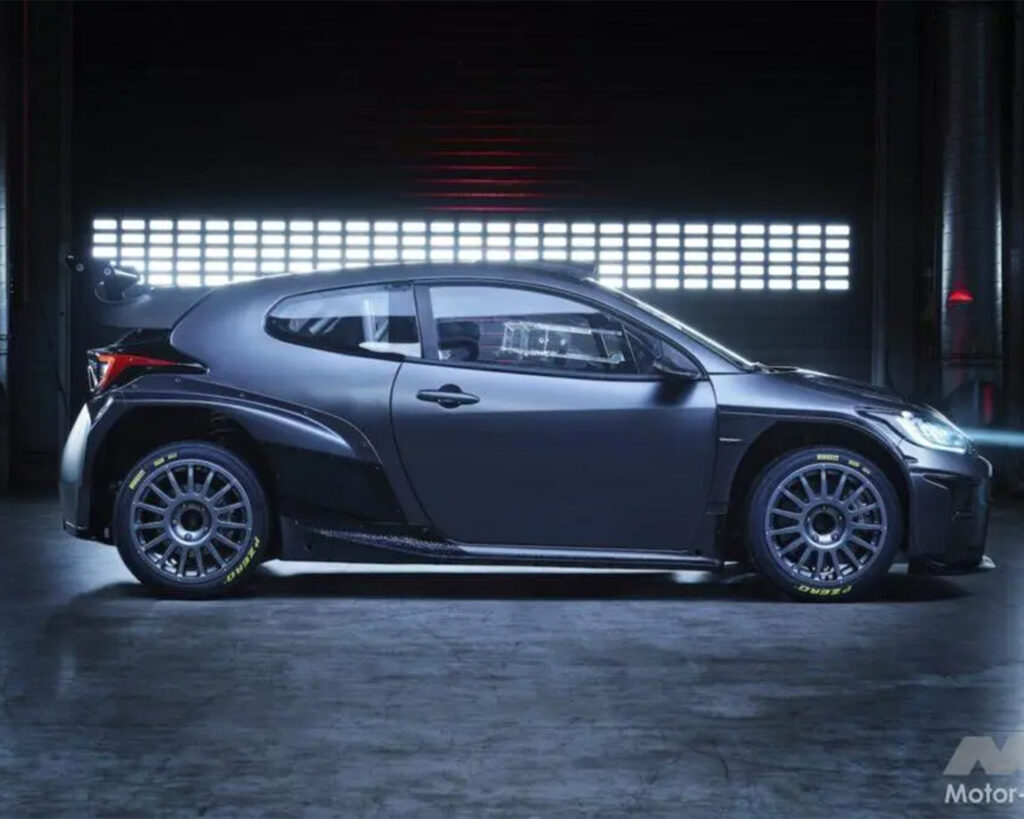
When the front ground clearance is lowered (I believe this is called the “rake angle”), the downward sloping press line becomes less noticeable (though it still slopes slightly downward), and it no longer clashes with the rear fender bulge.
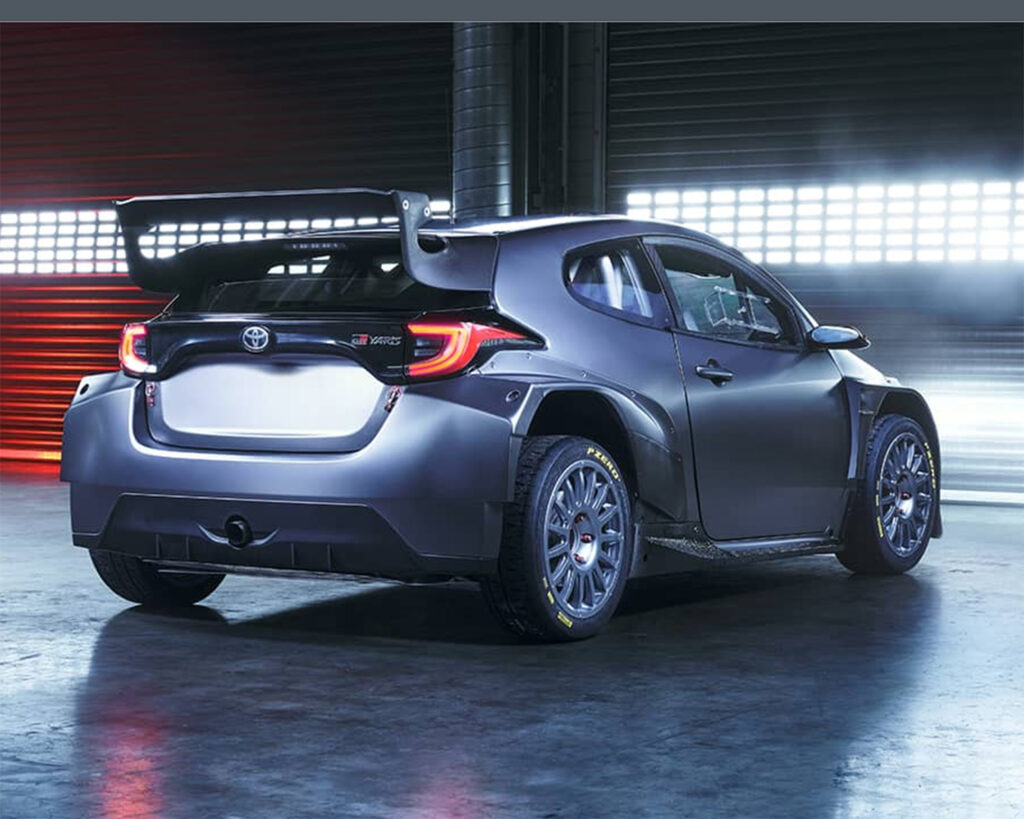
In the rear diagonal view (Photo 11), the treatment of the rear fender end creates a three-dimensional structure, with sharp and rounded elements working together to form a unified look with the adjacent areas.
Additionally, as seen in Photo 11, there’s a continuity and consistency between the shape of the rear spoiler’s support struts and the flat C-pillar. It makes me think that the C-pillar might have been intentionally flattened to guide air to the spoiler.
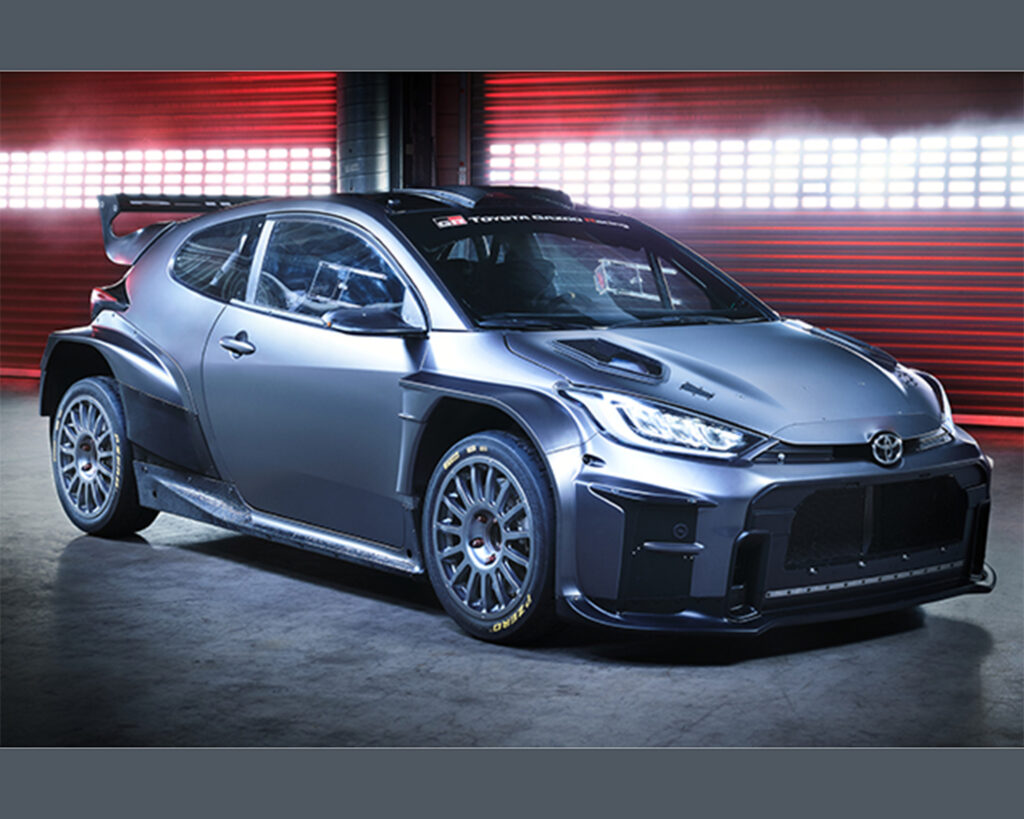
When viewed from the front diagonal, the side press line sloping towards the rear is clearly visible, but in Rally2, it adds a unique presence to the car.
Now, let’s assume for a moment that Rally2 represents a completed race car exterior design.
If you were to remove the rear spoiler and the front and rear over-fenders from Rally2, and level out the front and rear ride height for a production model, wouldn’t you end up with the GR Yaris we’re all familiar with?
In that case, all the strange flat surfaces, the double press lines that emphasize the indent rather than the bulge, the downward sloping side press line that disrupts the sense of speed, and Toyota’s press photos that skillfully hide these uncomfortable elements—all of it starts to make sense.
The odd design of the production model GR Yaris is a remnant of its racing heritage, and the purpose of the press photos is to highlight the strengths of the production model, so the uncomfortable aspects are hidden (though perhaps this intent became less clear in the later model press photos?).
Yes, that must be it. That explains everything. It’s settled. From now on, I’ll accept that this is the case.
Ah, now I feel relieved.
For me, someone who knows how perfectly natural the GR Yaris feels to drive, the discomfort of its exterior was like a fishbone stuck in my throat that I couldn’t swallow.
But now, I feel like I’ve finally swallowed it—or rather, it’s been removed with an endoscope, leaving me feeling clear. Yet, I still feel like the spot where the bone was stuck will continue to tingle for a long, long time.
This page was about the discomfort I feel with the GR Yaris’s side profile and how I’ve come to terms with it.
Postscript: Just as a reference, I’d like to briefly share my personal, biased view on the exterior of the GR Supra.
Below are images of the GR Supra from the front and rear diagonal angles. As always, these images are borrowed from Toyota’s web catalog. (Photos 12 & 13)
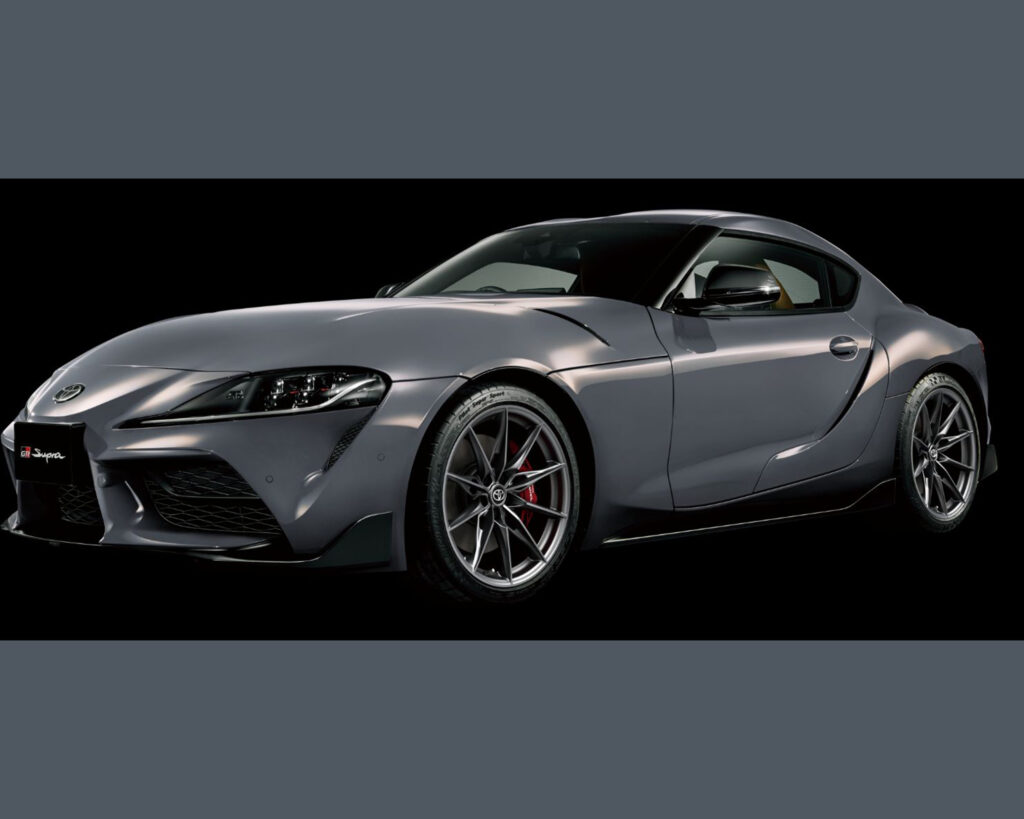
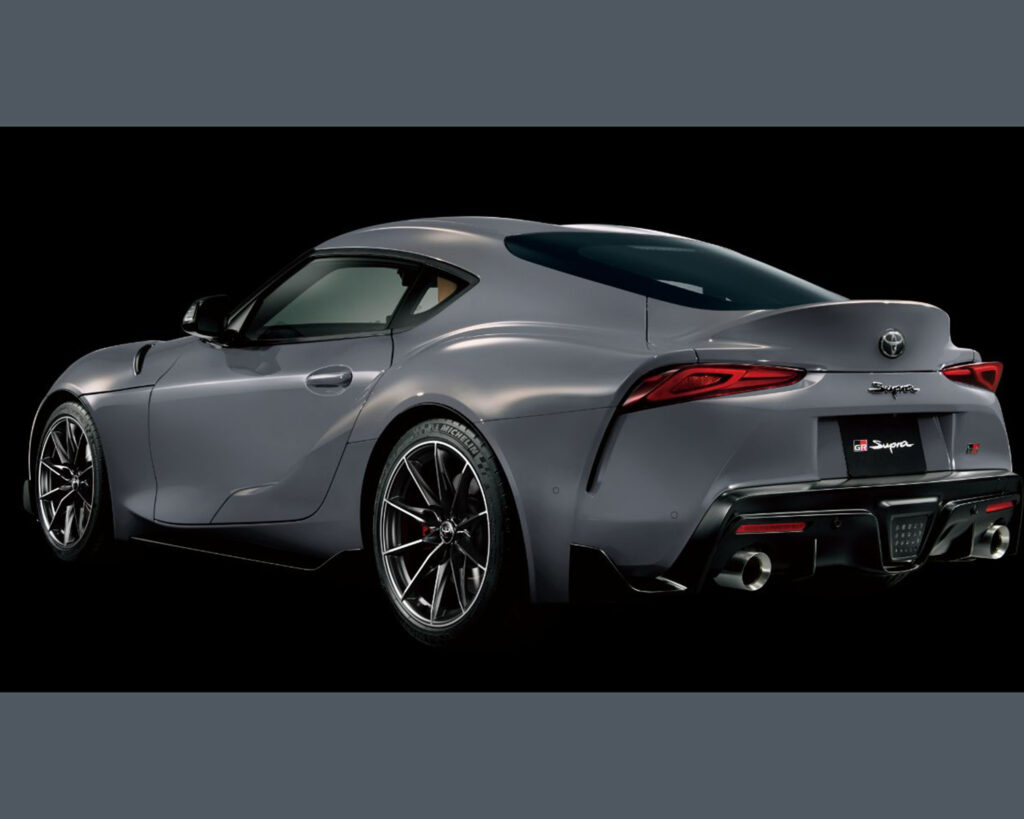
he GR Supra’s styling stirred up a lot of debate when it was first announced, with its quirky, experimental design elements. However, the rear-rising press line on the side gives the car the sense of speed that a sports car’s profile should have, turning this seemingly strange creation into a proper sports car.
So even though it looked weird at first, many people have probably come to find it cool recently. I’m one of them.
Design has such a powerful effect on human psychology. Exterior appearance, truly impressive. No wonder beautiful people are popular.
That’s all for now.
For other content on this site, please click the links below:
Table Of Content By Topic
PagesAbout Boating and Sailing
Pages About GR Yaris
Pages About OMDS (formerly Olympus) OM-1
Pages About Nissan Note e-POWER 4WD Pages About Life Hacks for Smooth Living
Pages About Second LIfe